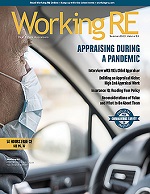 |
“One of the best courses that I have had in 17 years!” -Amy H
>> OREP E&O |
OREP/WRE Coronavirus Appraiser Blog
Coronavirus Appraiser Survey
Editor’s Note: This story is reprinted from the current print edition of Working RE magazine, mailing now. (Am I a Working RE Subscriber?)
Fannie Mae’s New Highest and Best Use
By Lee Lansford and Richard Heyn
Fannie Mae seems to have a problem with excess land. Or, perhaps more accurately, Fannie Mae seems to have a problem with appraisals that involve excess land, and the appraiser’s characterization of Highest and Best Use. Before we proceed with this discussion, let’s make sure everybody is on the same page by defining two terms: “surplus” land versus “excess” land.
Surplus land is land beyond what is necessary to support the highest and best use but cannot be sold off separately. To simplify things, think in terms of a house that sits on two lots in a subdivision. The house “straddles the line” between the two lots so neither lot can be sold off separately and the highest and best use is a continuation of the existing use. “Excess” land is land that is not needed to support the existing improvement and can be sold separately. In this case, think of a house and two lots where the house is located on one lot, leaving the excess lot free to be sold. If it helps you to remember the difference, excess land is “excellent” and surplus land “stinks.”
On the Fannie Mae/Freddie Mac appraisal forms, the question- “Is the highest and best use of the subject property as improved (or as proposed per plans and specifications) the present use?”- is followed by “Yes” and “No” checkboxes. If the subject property clearly has excess land, as in the case of the house on two lots described above, the correct answer to this question is usually “No,” followed by an explanation that the highest and best use involves treating the improved and unimproved lots as separate entities in the valuation process. The fallout from this is that Fannie Mae will not purchase loans involving appraisal reports if the “No” box has been checked.
Apparently, Fannie Mae has been looking for a workaround to this situation. In their “Appraiser Update” newsletter of December 2019, Fannie Mae advised appraisers that “Excess land is considered ‘value in use’ for the purpose of the appraisal, so the land should be described and its contributory value included in the grid.” That comment left numerous appraisers scratching their heads. The concept of “value in use” does not mesh with the definition of “market value” printed on the form, and thus did not resolve the issue of checking the “No” box regarding highest and best use.
In March of 2020, Fannie Mae issued another “Appraiser Update” and again discussed excess land. This newsletter began by quoting a line out of USPAP that states: “An appraiser must analyze the relevant legal, physical, and economic factors … to support the appraiser’s highest and best use conclusion(s).” The newsletter then stated that “Fannie Mae’s policy requires that the mortgaged premises must be the highest and best use of the property as improved (or as proposed per plans and specifications).” So far, so good. But here comes the fun stuff.
The article goes on to say that when applying the legal HBU test to multiple parcels, the Fannie Mae Selling Guide requires that the mortgage must cover each parcel, and consequently, excess land “is not a possible outcome of the HBU analysis because the parcels cannot be separated without mortgagee consent.” This amounts to a new, fifth test of highest and best use: Is the property encumbered with a mortgage?
What’s interesting about this new test is that the overwhelming majority of appraisals reported on Fannie/Freddie forms have the “Fee Simple” box checked under “Property Rights Appraised.” By definition, “Fee Simple” means Absolute ownership unencumbered by any other interest and subject only to taxation, eminent domain, police power and escheat. In other words, if an appraiser’s opinion of market value is developed within the context of “fee simple,” the appraiser ignores any mortgage. Another way of looking at this is that if a person owns a house and two lots free and clear (one of which is excess land), and then decides to mortgage the property, the highest and best use does not change overnight.
So, we have gone from a confusing position in the December 2019 newsletter to a dangerous position in the March 2020 newsletter. As one industry observer noted, “they should have quit while they were behind.” The reason the latter position is dangerous to appraisers it that it appears to put them at odds with USPAP and their State Regulatory Agency.
Standards Rule 1-1(a) calls for appraisers to “be aware of, understand, and correctly employ those recognized methods and techniques that are necessary to produce a credible appraisal”; yet in no recognized source with which the authors are familiar does highest and best use depend on whether the property is encumbered with a mortgage. So for now, when dealing with excess land and Fannie Mae policy, appraisers should ask themselves if the risks are worth it, or if these assignments are best turned down. In that light, we’ll close this discussion with a final quote from USPAP: “An appraiser must not allow assignment conditions to limit the scope of work to such a degree that the assignment results are not credible in the context of the intended use.”
>> Join the Discussion at OREP/Working RE’s Coronavirus (COVID-19) Discussion and Resource Page/a> where you can share your thoughts, experiences, advice and challenges with fellow appraisers.
>> Take OREP/Working RE’s Coronavirus: State of the Appraisal Industry survey here.
About the Author
Lee Lansford, ASA & IFA, is a Certified Residential Appraiser with 30+ years of experience. He holds an MBA (R.E. Finance & Urban Development) from DePaul U. (Chicago) and is an AQB Certified USPAP Instructor. He served for 9 years as a member of the State of IL Appraisal Board where for 2 years he was chairman. Previously, Lee had served as an “investigative reviewer” for the state’s appraiser licensing agency and is currently serving as a ‘hearing officer’ for real estate tax assessment appeals (office of Supervisor of Assessments) in his home county. A designated member of the American Society of Appraisers, Lee is in private practice in “Chicago-land.”
Richard Heyn, SRA, has over 40 years of experience in real estate appraisal, consulting, seminar development and teaching. Rich is an AQB certified USPAP instructor and has authored dozens of continuing education seminars for appraisers, REALTORS© and lenders. His seminars have been attended by literally tens of thousands of appraisers from every State.
Sign Up Now! $119 (7 Hrs)
OREP Insured’s Price: $99
>Opt-In to Working RE Newsletters
>Shop Appraiser Insurance
>Shop Real Estate Agent
Insurance
Send your story submission/idea to the Editor:
isaac@orep.org




by Bob Hatfield
Interesting article that raises the question: is “legally permissible” limited to government, i.e. zoning and land use? Probably not, since deed restrictions have nothing to do with either yet are clearly a factor in legally permissible; therefore, the deed of trust (in Texas) that is filed to protect the lender is, by extension, a deed restriction – and so the prohibition against subdividing the tract on which a dwelling straddles lot lines could be interpreted to be in perpetuity, i.e. as long as the lien is in place. That ‘logic’ follows the GSEs and HUD’s “quasi-PUD” theory that requires PUD reporting for any mandatory HOA, even though PUD is a zoning description (in Texas). This is really good stuff that proves no matter how much USPAP would love the One World Order, as long as it remains an unfunded federal mandate there will be up to 50 interpretations…including H&BU.
-by Ronald G Waldschmidt
HOW WOULD YOU TREAT A SITE THAT IS LOCATED BOTH SAN FRANCISCO AND SAN MATEO CALIFORNIA COUNTIES WITHIN THE CITIES LIMITS.
-by Brad Bassi, SRA
Leave it to Fannie to make a bad situation worse and thanks to Rich and Lee for stepping off the curb without getting hit by a bus. The real question is will Fannie listen. I ask because I got into a knock down verbal altercation over just this topic. Won’t go into the details, boring and frankly I don’t really want to relive the nightmare. But if Fannie keeps trying to fix something just so they can do a loan we will continue to be in a bigger pickle. Thank you folks for your effort on this rather large mess. Film at 11, keep us updated if they change it again, which I am sure they will.
-